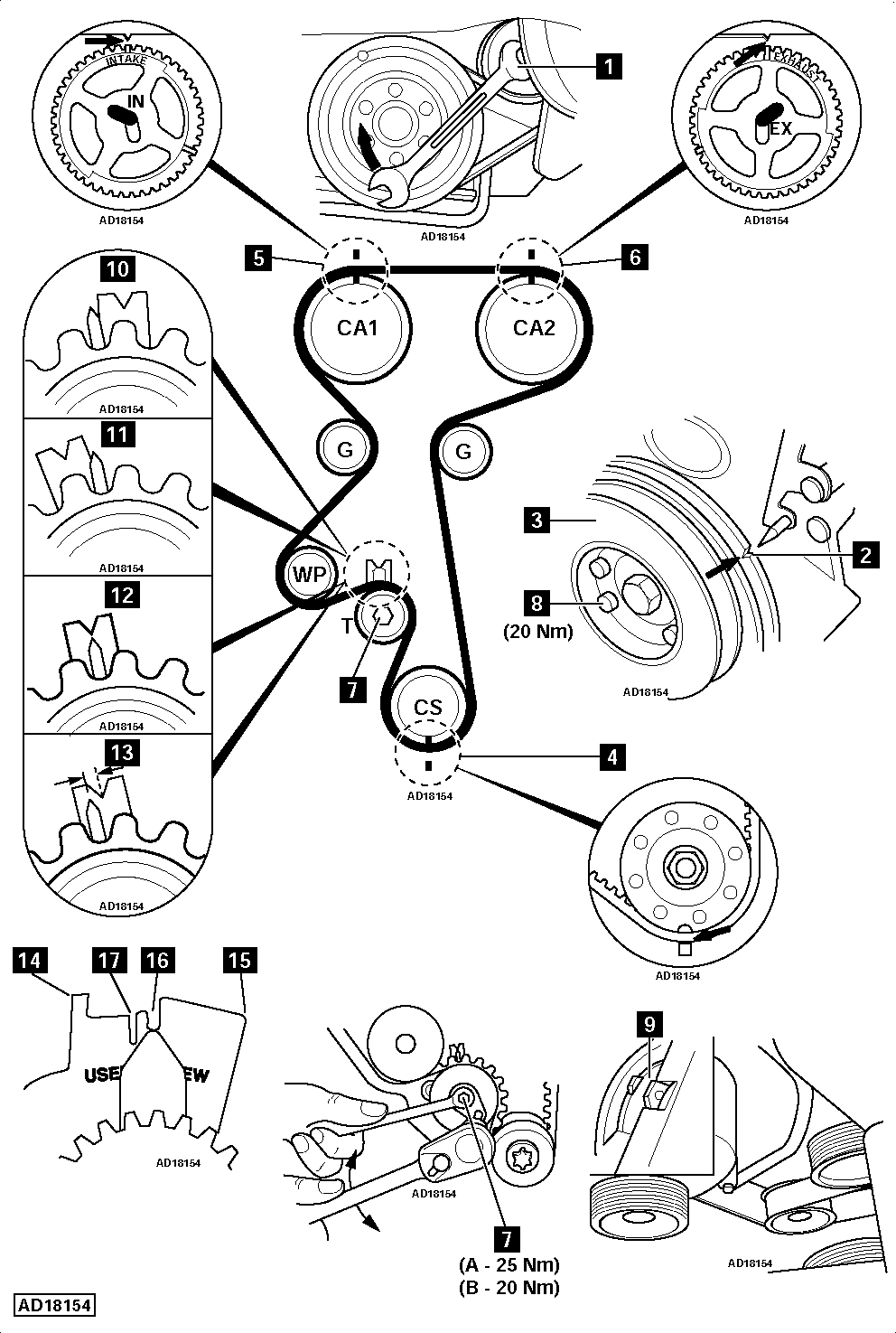Replacement Interval Guide
- Vauxhall recommend replacement as follows:
- 95MY – replacement every 36,000 miles or 4 years, whichever occurs first.
- 96MY – replacement every 40,000 miles or 4 years, whichever occurs first.
- 97MY→ – replacement every 40,000 miles or 4 years, whichever occurs first (tensioner pulley must also be replaced).
- Z22XE – guide pulley(s) must also be replaced.
- The previous use and service history of the vehicle must always be taken into account.
Check For Engine Damage
CAUTION: This engine has been identified as an INTERFERENCE engine in which the possibility of valve-to-piston damage in the event of a timing belt failure is MOST LIKELY to occur. A compression check of all cylinders should be performed before removing the cylinder head.
Repair Times – hrs
| Remove & install: | |
|---|---|
| Sintra | 1,70 |
| Omega-B | 0,80 |
| Frontera | 0,80 |
| AC | +0,20 |
| Frontera-B | 0,70 |
Special Tools
- Frontera/Sintra: Camshaft sprocket locking tool – Kent Moore No.KM-832.
- Omega-B: Camshaft sprocket locking tool – Kent Moore No.KM-853.
Special Precautions
- Disconnect battery earth lead.
- DO NOT turn crankshaft or camshaft when timing belt removed.
- Remove spark plugs to ease turning engine.
- Turn engine in normal direction of rotation (unless otherwise stated).
- DO NOT turn engine via camshaft or other sprockets.
- Observe all tightening torques.

Removal
WARNING: Certain engines require modification to tensioner pulley/guide pulleys due to possible failure. Refer to dealer.
- Mark direction of rotation on auxiliary drive belt with chalk.
- Turn auxiliary drive belt tensioner clockwise to release tension on belt [1] .
- Remove auxiliary drive belt.
- Turn crankshaft clockwise until timing marks aligned [2] .
- Omega: Reposition pipes and wiring adjacent to timing belt cover.
- Remove:
- Engine undershield.
- Crankshaft pulley bolts [8] .
- Crankshaft pulley [3] .
- Timing belt cover.
- Turn crankshaft clockwise until timing marks aligned [4] , [5] & [6] .
- Lock camshaft sprockets. Use tool No.KM-832/853.
- Slacken tensioner bolt [7] .
- Turn tensioner clockwise until pointer on LH stop. Use Allen key.
- Type 1 – [10] .
- Type 2 – [14] .
- Lightly tighten tensioner bolt.
- Remove timing belt.
Installation
- Ensure lug on water pump aligned with corresponding lug on cylinder block [9] .
- Ensure timing marks aligned [4] , [5] & [6] .
- Ensure locking tool located correctly.
NOTE: Sprockets fitted to inlet camshaft (CA1) and exhaust camshaft (CA2) have similar timing marks. If camshaft sprockets have been removed: Ensure correct dowel location of sprockets on camshafts and timing marks aligned with ‘INTAKE’ [5] and ‘EXHAUST’ [6] marks respectively.
- Fit timing belt in anti-clockwise direction, starting at crankshaft sprocket. Ensure belt is taut between crankshaft sprocket and exhaust camshaft sprocket (CA2).
NOTE: Belt adjustment must be carried out when engine is cold.
- Slacken tensioner bolt [7] .
- Turn tensioner anti-clockwise until pointer on RH stop.
- Type 1 – [11] .
- Type 2 – [15] .
- Lightly tighten tensioner bolt [7] .
- Remove locking tool.
- Turn crankshaft two turns clockwise. Ensure timing marks aligned [4] , [5] & [6] .
- Slacken tensioner bolt [7] .
- Turn tensioner clockwise until pointer aligned as follows:
- Type 1:
- New belt – ‘V’ notch in bracket [12] .
- Used belt – LH edge of ‘V’ notch [13] .
- Type 2:
- New belt – ‘NEW’ notch in bracket [16] .
- Used belt – ‘USED’ notch in bracket [17] .
- Tighten tensioner bolt.
- (A) →2000: 25 Nm [7] .
- (B) 2000→: 20 Nm [7] .
- Install components in reverse order of removal.
- Tighten crankshaft pulley bolts to 20 Nm [8] .
NOTE: Observe direction of rotation marks on auxiliary drive belt.